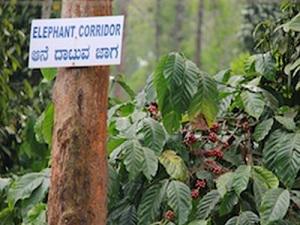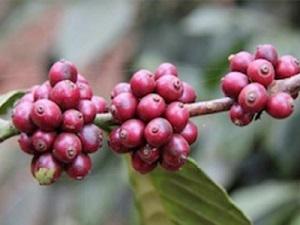Arshiya Urveeja Bose
This project explores opportunities for conserving biodiversity within coffee plantations in Kodagu through a democratic partnership with coffee growers. Ecological guidelines for coffee farms and an incentives framework will be developed to encourage growers to take tangible steps towards sustainable and biodiversity-friendly agriculture practices.

Elephant corridor through coffee estates.
Coffee cultivation in India is unique since 100% of coffee is grown under shade of forest tree species. In India, coffee agriculture began as a family-based livelihood where traditions of sacred groves, integrated-crop-management and various socioeconomic factors evolved practices wherein coffee was inter-planted within the existing forest ecosystem. Even today, coffee farms maintain a diversity of native shade trees and nurture habitats that support diverse, endemic and endangered wildlife species. However, much of these sustainable agroforestry practices are fast eroding. Complex cultural and economic tensions have created fractures in an erstwhile biodiversity-friendly production system. These tensions include proximity to markets, changing demands and supply of Indian coffee, market-speculation and farmer’s aspirations of increased productivity. At an ecosystem level, changed farming has been realised as increased use of toxic chemicals and dramatic changes to the layout of farms. Native, tree species have been rapidly removed or replaced by exotics such as silver oak.

Coffee beans.
Initial studies have measured the loss of biodiversity from farms as significant. However, ecosystem threats and incentive opportunities have not as yet been evaluated from the perspective of coffee growers and there is a lack of a meaningful conservation plan. This project aims to address this crucial gap.
The core intent is to establish groundwork for a long-term conservation of biodiversity on coffee farms.
This project focuses on the following:
a. Understanding farmer perspectives on nature-friendly farming: This project explores motivations and openness of coffee growers towards adopting sustainable practices. Understanding coffee production from a grower’s perspective is crucial to conceptualising how to encourage biodiversity conservation. Additionally, this project will address environmental threats by documenting the pressures and rationale behind changing farming practices and transition to unsustainable production.
b. Developing a ‘Coffee and Conservation Strategy’ (CCS): At present, no guidelines exist that are both ecologically meaningful and feasible for farmers. The project will develop a Coffee and Conservation Strategy (CCS). The CCS would consist of two components: (i) ecological standards for coffee farms and (ii) incentive framework.
(i) Ecological Standards: This project will develop ecological standards that coffee growers would be required to follow. These standards would specify parameters, such as shade tree density and diversity, chemical use, soil and water conservation and proactive biodiversity protection.
(ii) Incentive Framework: This project will develop, through extensive and participatory process a range of economic and non-economic incentives that would compensate costs and encourage conservation practices. This framework would encourage and incentivise farmers to support CCS and with enthusiasm follow ecological standards.
c. Building partnerships with coffee growers: This project will establish an open dialogue and partnership with coffee growers about conservation. Relationships with farmers have already been established during a pilot phase. By strengthening these relationships, the project will gain farmers’ commitments on CCS.
This project will identify incentive opportunities and evaluate which incentives would be effective given the local context. Finally, the contribution of this project will also be significant to coffee growers since farmers will be positioned at crux of the process as primary drivers of conservation.